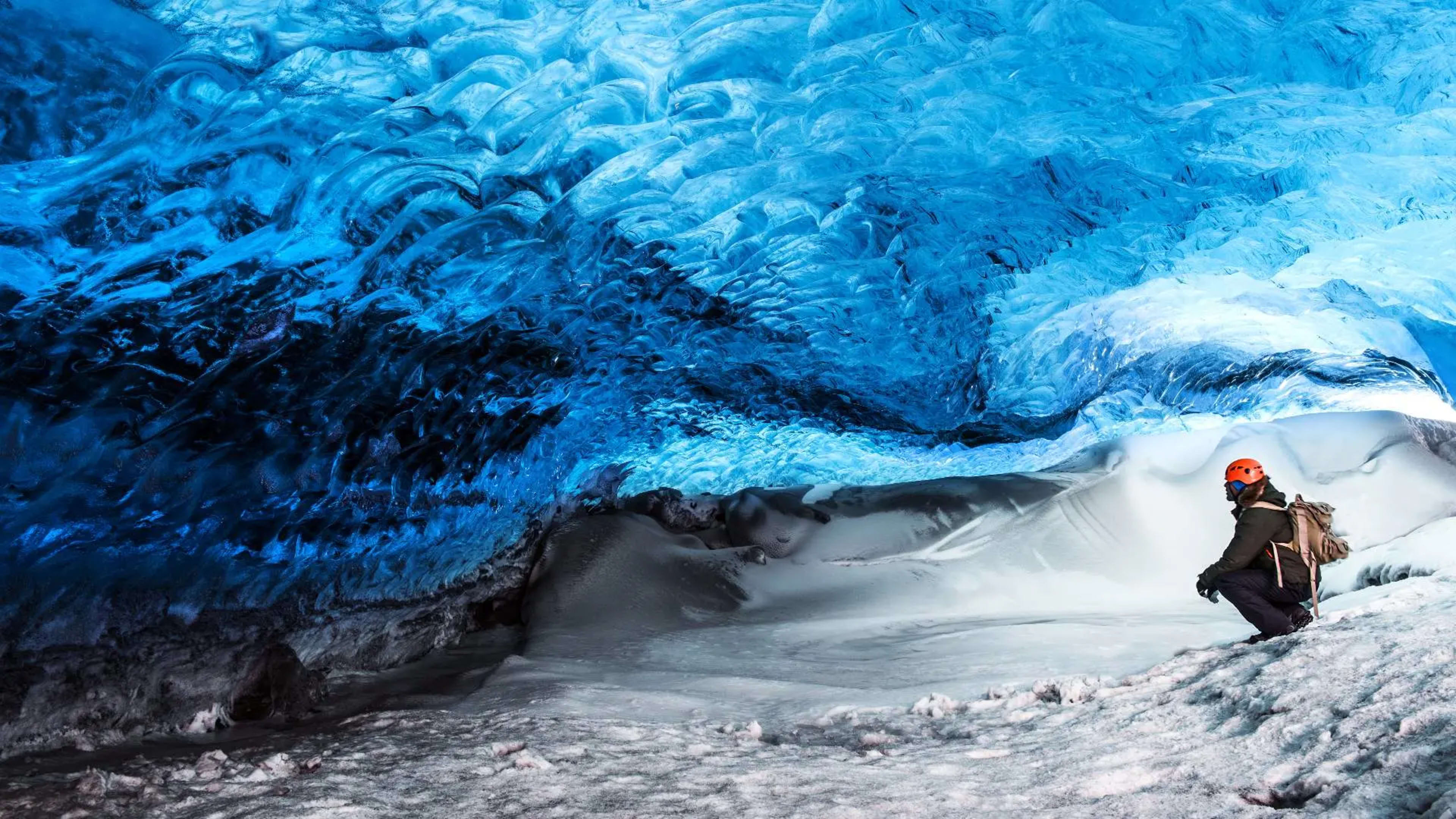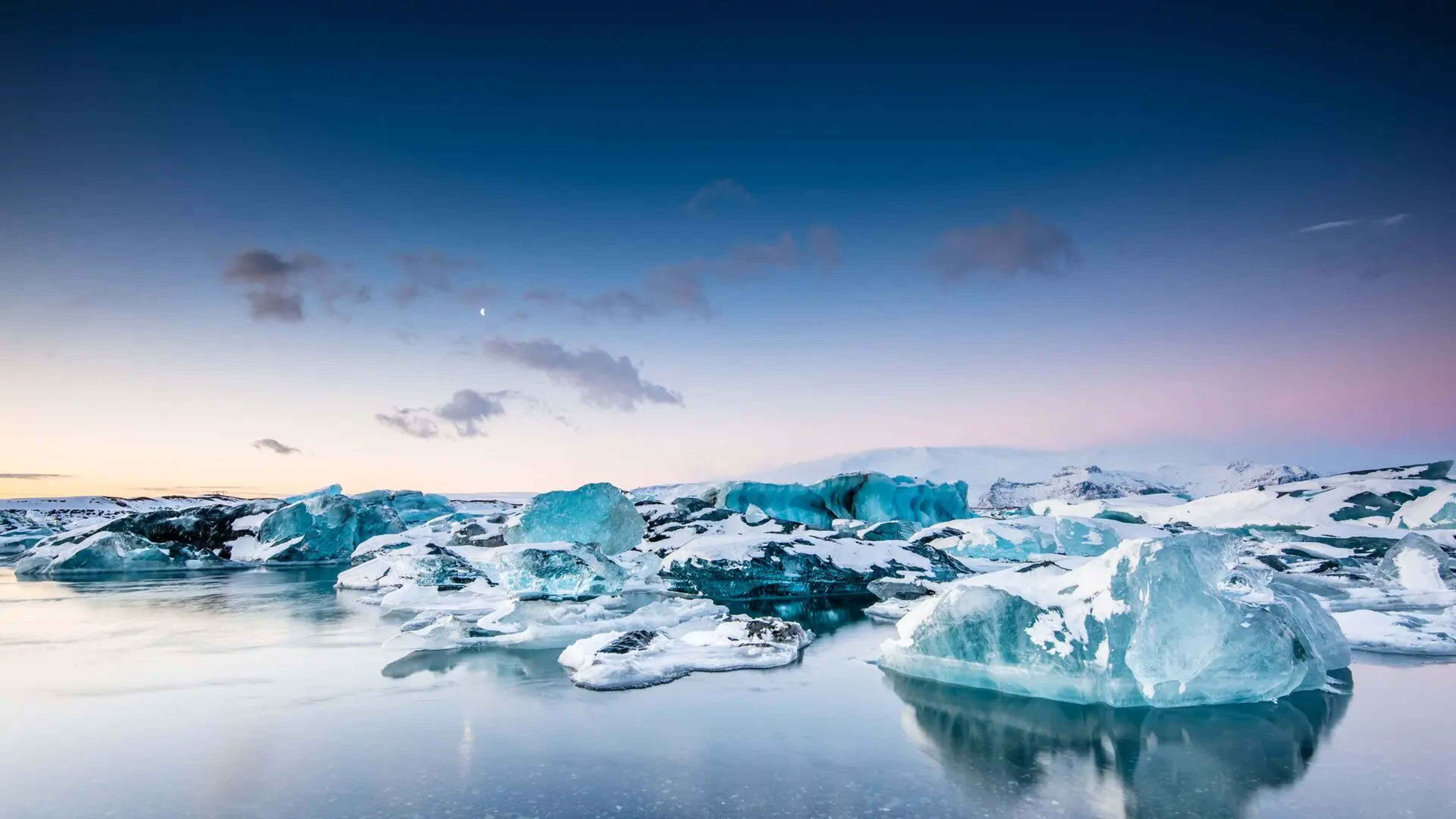The moment you arrive in Iceland during winter, you’ll notice it: light hits differently in this Nordic wonderland. Instead of starkly bright days transitioning into dark, the sun hangs low, hugging the horizon for hours. The effect is cinematic; a sunrise that never quite finishes or a sunset that stretches into eternal twilight.
This dramatic light cycle is a result of Iceland lying below the Arctic Circle. For winter travelers, the short days may introduce some unique planning challenges. Don’t worry; understanding the limited hours of daylight in Iceland by month is the first step of your dream trip.
Read on for expert guidance on how to plan winter drives and maximize those precious hours of light—and darkness—in Iceland.
Explore our winter tours to start planning your cold-weather adventures in Iceland.
Overview: How Iceland’s Latitude Affects Daylight
The extreme daylight shifts in Iceland are purely due to its high-latitude location. It sits below the Arctic Circle (except for the remote island of Grimsey that’s inside), subject to the Earth’s axial tilt.
In summer, when the Northern Hemisphere tilts toward the sun, Iceland gets the famed midnight sun with nearly 24 hours of light. In winter, it angles away from the sun, which limits daylight dramatically. Around the winter solstice in December, Reykjavík receives as little as four to five hours of direct sunlight.

Planning Your Trip: Hours of Daylight in Iceland by Month
The most critical part of planning a trip to Iceland is understanding the hours of daylight in Iceland by month. Besides informing expectations of the country, it also allows you to choose the best time to visit Iceland for the seasonal experiences you’re eyeing.
- January: One of the two darkest months. January starts with only four hours of daylight, gradually increasing to six hours by the end. Perfect for the Northern Lights.
- February: Rapidly gains light, jumping from about seven to about 10 hours of daylight. Day trips become noticeably longer during this month.
- March: Days are roughly equal to nights. Daylight increases from 10 to almost 13.5 hours, so this is an excellent time for balancing sightseeing and aurora chasing.
- April: A true sign of spring. Daylight tends to lengthen rapidly during this period, reaching between 13.5 and 16.5 hours. Long days are already ideal for road trips and outdoor activities.
- May: Approaching the midnight sun, with daylight lasting from 16.5 to 20 hours. There’s no true darkness anymore, only a bright twilight at night.
- June: The peak of midnight sun. June features nearly 24 hours of usable daylight, with the sun barely dipping below the horizon around the summer solstice.
- July: Maintains the midnight sun effect, with over 20 hours of continuous light. It has slightly fewer daylight hours than June. However, July has the warmest average temperatures, making it ideal for difficult hikes and extended outdoor excursions.
- August: The beginning of daylight’s retreat. Daylight decreases from 18 to about 14.5 hours. Nights become dark enough again for Northern Lights viewing by late August.
- September: A balanced month with 11.5 to 14.5 hours of daylight. A favorite for travelers as night returns for reliable Northern Lights hunting.
- October: Daylight drops significantly from about 11.5 hours to 8.5 hours. Long, dark nights make this a prime month for the aurora.
- November: Rapidly heading into winter darkness, decreasing from 8.5 hours to as little as five hours. You must plan activities around a shorter daylight window.
- December: The darkest month, with a minimum of just four hours of daylight around the winter solstice. However, the long twilight still provides some usable light.
Daylight Hours in Iceland Across Regions
In Iceland, your experience of light can depend on your location. The fundamental geographical rule goes like this: the farther north you go, the more extreme the seasonal shift becomes.
During the summer months, the effect of the midnight sun is amplified in the north. Northern areas like Akureyri and the Westfjords enjoy nearly 24 hours of usable light for driving and sightseeing.
In deep winter (December and January), the South and East Coasts (including areas like Höfn or Vík) get slightly more daylight. Travelers in the north can see up to an hour less sunlight than in the south. Some areas, like the deep fjords, even have surrounding mountains that block the sun entirely for weeks.
Curious about the wild, remote Westfjords? Learn more about it with our Westfjords travel guide.

Best Experiences in Iceland by Season
Winter (December to February)
With the shortest hours of daylight in Iceland by month, winter offers the absolute best opportunity to witness the Northern Lights. The long hours of darkness create a magical stage for the dancing aurora borealis in secluded areas. Simultaneously, the festive Christmas lights cast a warm, beautiful glow that brightens up the larger Icelandic towns.
Limited daylight hours also perfectly align with thrilling seasonal activities like exploring natural ice caves and enjoying snow sports. Meanwhile, bathing in geothermal lagoons like the Blue Lagoon offers a perfect, steamy contrast to the icy, snowy landscape.
Spring (March–May)
Iceland's shoulder seasons can pass by in a blink, as the transition between the extreme seasons is often quick. Early spring can be as cold as winter, but the increasing daylight is ideal for outdoor adventures. Longer, warmer days signal the start of whale watching season in April, while offering great conditions for hiking and sightseeing.
This is also the best time for chasing cascades as spring melt means the mighty Icelandic waterfalls flow most powerfully. In early spring, before the nights become too bright, you still have a decent chance for one last Northern Lights hunt.
Summer (June–August)
Summer is widely regarded as the best time to visit Iceland, thanks to the surreal phenomenon of the midnight sun. With nearly 24 hours of daylight, your opportunities for adventure are virtually endless. Plus, F-roads open in mid- to late-summer, making it possible to hike the raw beauty of the Highlands.
The milder weather makes all outdoor activities ideal, from glacier hiking and kayaking to endless sightseeing. Summer is also the peak wildlife season. Keep an eye out for puffins nesting on coastal cliffs and majestic whales breaching the calm northern seas.
Autumn (September–November)
Like spring, autumn is considered a blink-and-you'll-miss-it shoulder season in Iceland. It offers a brief but spectacular transition between the midnight sun and the deep winter darkness. The drop in temperature means many winter activities are often available early, like Northern Lights and ice caves.
Autumn is also one of the best times for scenic drives. Before the heavy snow sets in, the landscapes transform into fiery shades of red, orange, and gold. It’s particularly stunning in areas with birch forests and mossy fields, like Þingvellir National Park or the forests around Hallormsstaðaskógur.
Planning a trip to Iceland but can’t quite decide when? Read about the best times to go to Iceland for insider info and tips for each season.
Driving in Iceland During Winter Daylight Hours
Limited hours of daylight, unpredictable weather, and tricky road conditions. Driving in winter can definitely be challenging, especially in Iceland. It’s not impossible, though, with careful planning and responsible navigation.
- Plan Day Trips: Schedule your sightseeing, hiking, and driving between the late morning sunrise and early afternoon sunset. That way, you avoid driving on often icy, unlit roads in pitch-black dark, especially outside of major towns.
- Utilize Twilight: The twilight period before sunrise and after sunset is extended in Iceland. You can often begin driving an hour or two before the official sunrise, and continue for a short time after sunset before it becomes completely dark.
- Get a 4x4: A four-wheel-drive vehicle is highly recommended, even if you’re sticking to major roads. It’s best for stability and traction on snowy or icy surfaces, which can be prevalent even on the Ring Road.
- Check Conditions Constantly: Before every drive, consult the official websites for road conditions (road.is) and weather forecasts (vedur.is). The conditions change rapidly in winter, and a clear road can become dangerous within minutes.
- Flexibility is Key: The short days mean less time to complete your itinerary. Be prepared to cancel or postpone activities if high winds or road closures are in effect. Prioritize safety over schedule, always.
- Be Aware of Road Laws: Drive slowly for safety, and keep headlights on at all times, as required by Icelandic law.
- Secure Your Trip with a Self-Drive Package: Enjoy the freedom of a road trip without the stress of planning. Our winter self-drive tours include the rental car, accommodations, and 24/7 local helpline support for your entire Iceland vacation.
Recommended Winter Tours to Maximize Daylight
The limited hours of daylight in Iceland means that winter travel requires expert planning to make the most of your trip. For a smooth, seamless experience, choosing a guided tour may be your best bet!
For instance, our 8-Day Northern Lights Ring Road Tour is ideal for a trip circling the whole island. This guided small-group tour takes you to legendary Ring Road sights: frosted waterfalls, stunning black sand beaches, and otherworldly geology. Winter days may be short, but nights are spent in the countryside. Here, you’ll have the best chance to chase the Northern Lights away from city lights.
Alternatively, consider our six-day Reykjavík Ultimate Winter Getaway & Northern Lights multi-day bus tour. This unique package bases you in the buzzing capital of Reykjavík, allowing you to return each evening. Guided bus excursions during the day cover the iconic Golden Circle and South Coast, while evenings are dedicated to guided Northern Lights outings.
For a festive winter getaway, the Active Christmas Adventure with Blue Lagoon is a fun five-day option. From your Reykjavík base, you’ll tour the Golden Circle for classic wintry sights like geysers and waterfalls. It culminates in a relaxing Christmas Eve: a soak in the Blue Lagoon, a festive dinner, and the chance to glimpse the aurora over the fairy-lit capital.
Practical Tips for Planning Trips Around Daylight Hours
- Reverse Your Schedule: Use the dark mornings for leisurely indoor time, like enjoying a breakfast with views, visiting a museum in Reykjavík, or driving the first leg of your route. Save your main, outdoor activity for the peak light hours (typically 11 am to 3 pm).
- Slot in Nighttime Activities: Utilize the long hours of darkness for experiences that are only possible after sundown. This is the ideal time for Northern Lights tours, stargazing, or soaking in the warm, geothermal waters of the Blue Lagoon.
- Book Light-Dependent Activities Early: Specialized tours like ice caving and glacier hiking are often scheduled in the middle of the day for maximum safety and light. Book these well in advance, and confirm the specific time slot.
- Allow for Buffers: Because travel is slower in winter, you must add extra time to your plan. Icy roads, unexpected snow, or waiting for conditions to improve can easily add an hour to a drive that Google Maps suggests is only 30 minutes.
- Check Conditions Daily: Weather and road conditions change rapidly. Always take a peek at road.is and vedur.is before setting out. Never underestimate road closures or poor visibility due to snow and high winds.
- Consider a Guided Tour: Guided multi-day tours are designed to manage the limited light, unpredictable weather, and road safety. Thus, you get the best chance of visiting the main sights at the optimal time of day.
Embracing Iceland’s Unique Daylight Cycle
Iceland’s winter light cycle is a breathtaking limbo: days are short, but the low-hanging sun creates a prolonged golden-hour spectacle. By knowing the hours of daylight in Iceland by month, you can experience the best of the season.
Use the limited daylight for stunning sightseeing at iconic natural wonders. As night falls, dedicate the extended darkness to the hunt for the Northern Lights and relaxing in geothermal spas. Don't let the darkness deter you; it's part of the adventure. Iceland Tours can help you plan a trip that embraces the light and dark of winter.
- Check out our six-day guided group adventure and marvel at the winter wonders of Iceland with us.
FAQ: Daylight Hours in Iceland
How many hours of daylight do you get in Iceland?
The amount of daylight varies drastically by season. It ranges from approximately 4–5 hours in deep winter (December) to nearly 24 hours during the summer (June).
What is the darkest month in Iceland?
December is the darkest month in Iceland, with the shortest days occurring around the winter solstice.
How long is the shortest day of the year in Iceland?
The shortest day of the year in Reykjavík is just over four hours of daylight, occurring around December 21.
Why is Iceland dark for six months?
Iceland is not dark for six months. It experiences extreme variations in daylight due to its high latitude, but the sun still rises daily, even in winter.
Does the sun stay up 24 hours in Iceland?
Not entirely. Iceland experiences the "Midnight Sun," where the sun dips only slightly below the horizon, resulting in very bright twilight.
What is the best month to visit Iceland?
The "best" month depends on your goals: December to February is best for Northern Lights and ice caves, while June to August is best for the Midnight Sun and hiking the Highlands.




